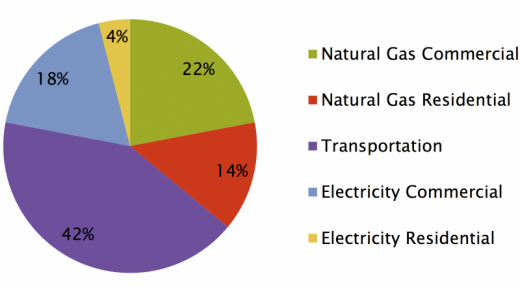In the field of climate change policy, you might think the State of California —arguably home of the world’s most robust policies to reduce greenhouse gases — has got everything covered. And, you’re mostly right. From Sustainable Communities Strategies and cap and trade to the low-carbon fuel standard, Renewable Portfolio Standard, green building code and aggressive new targets set by Governor Brown, the state has adopted a suite of climate policies that are far-reaching, ambitious and cover nearly every sector of the economy to distribute the burden of investing in a cleaner environment.
But, as it turns out, there are many complementary actions that local and regional entities can take to extend these gains even further, providing cleaner air, resource efficiency and more resilient energy systems. Last month, a group of experts (including SPUR) completed a year-long study for the Bay Area Air Quality Management District that highlights three ways we can significantly clean up our air by making cleaner energy choices:
1. Improve energy efficiency to reduce the overall amount of energy resources needed to achieve the same economic benefit
2. Electrify all energy uses, i.e., switch in electricity instead of burning natural gas or gasoline for heating, cooling and transportation
3. Increase the amount of renewable energy sources in how this electricity is generated
The Air District took on this study in order to advance the Bay Area’s response to climate change beyond what current state and local actions will achieve, and it is institutionally set up to help lead this change. The first regional air pollution control agency established in the United States, it regulates the major sources of greenhouse gases and other emissions in our nine-county airshed. It studies how better air protects public health and advances policy and emissions permits to that end. And it provides grants to reduce emissions from transportation, especially in toxic air hot spots. Over time, the district’s activities have improved public health for Bay Area people. For example, the number of premature deaths due to air pollution declined by 3,600 per year between the 1980s and 2008. Lifetime cancer risk from toxic air contaminants declined by 70 percent in the Bay Area between 1990 and 2008.
But during this time, emissions and concentrations of greenhouse gases have gone up. To address this, the Air District adopted a goal in 2013 of reducing greenhouse gas emissions 80 percent below 1990 levels by 2050. Implementation steps included (among other things) monitoring carbon emissions, developing new rules, expanding enforcement, developing a climate strategy and studying the Bay Area’s energy future to better understand the trends and opportunities that could have an economy-wide impact on emissions over the long run.
The new study, led by the district’s advisory council, was undertaken through a series of hearings with leading scientists and policy makers to learn what parts of a clean energy future are ready to happen on their own, and what pieces need additional policy to dramatically reduce greenhouse gas emissions. (You can watch all of the testimony by webcast if you have a lot of free time.)
The Bay Area’s energy use is significantly embedded in natural gas and transportation fuels like gasoline (see chart below), so electrifying these energy needs will be one of the region’s biggest challenges.
The Bay Area’s Energy Consumption in 2012

Source: California Energy Commission and Air Resources Board, as referenced in the 2014 Report on the Advisory Council’s Activities to the BAAQMD Board of Directors, April 15, 2015 (p. 21)
Some other observations the advisory council made in its year of research included:
- It appears both possible and economically feasible, viewed from a business-as-usual scenario, to meet and surpass California’s climate goals while ensuring the reliability of the electricity grid.
- It may even be possible to transition to a 100 percent renewable energy system for all end uses (electricity, transportation, heating and cooling), mostly by scaling up utility-scale solar plants and large wind arrays.
- Energy storage technologies, especially ways to store renewable energy near where it is generated, need improvement and innovation, as they are needed to balance loads on the grid as renewables scale up.
In the end, the advisory council recommended that the Air District:
1. Continue to advance feasible controls and rules for clean air by considering multiple air pollutants together, including greenhouse gas emissions, and balancing tradeoffs among them.
2. Explore opportunities to reduce emissions from large numbers of small sources like water heaters and boilers.
3. Include clean energy as a criteria in grantmaking.
4. Study how to expand grid-supporting energy storage, instead of allowing the continued proliferation of gas-fired backup generators throughout the Bay Area.
SPUR will be continuing to research the Bay Area’s energy future through a new project launched this year. We will recommend all actions necessary — by all potential agents of change — for a fossil-fuel-free region. We believe the Bay Area can continue its climate action progress and demonstrate to California and the world how to meet all our energy needs with clean energy, even as we grow by two million people by 2050. Stay tuned for a new SPUR report on this topic in 2016.
Read the four Air District briefs on the Bay Area’s energy future:
The Path Forward for the Energy Sector Toward California's 2050 Greenhouse Gas Goal
Energy and Climate Opportunities for the Bay Area
The Integrated Grid: Energy Storage and Smart Grid Technologies and their Relationship to 2050 Goals
